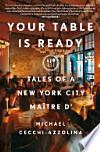You have /5 articles left.
Sign up for a free account or log in.
 Your Table Is Ready: Tales of a New York City Maître D’ by Michael Cecchi-Azzolina
Your Table Is Ready: Tales of a New York City Maître D’ by Michael Cecchi-Azzolina
Published in December 2022
Reading about restaurants and restaurant culture is something I love to do. Blame it on Kitchen Confidential. There is something about the parallels between restaurants and campuses, chefs and professors, dining rooms and classrooms, diners and students, and kitchens and labs that I find endlessly fascinating.
Even with all this restaurant reading, until listening to Your Table Is Ready (I listened to the audiobook version, fabulously read by the author), I could not have told you what a maître d’ does. Admittedly, I’ve likely read more books about upscale restaurants than I’ve experienced as a guest. (“Guests” are what customers are called in fancy eating establishments).
The sit-down restaurants that I tend to visit have hosts, not maître d’s. As I learned in Your Table Is Ready, my inexperience with maître d’s is less about my limited fine dining experience and more about some changes that the IRS made in the 1990s to crack down on underreported income from tipping. Before the IRS rule change, the maître d’ participated in the tip pool. After the rule change, maître d’s were classified as managers, ineligible to be compensated by the shared tips of servers.
The impact of this tax law change was, at all but the most high-end of establishments, the deprofessionalization of the role in the restaurant formerly played by the maître d’. Where once the person who greeted you when you arrived at the restaurant and showed you to your table was among the highest ranking (and best paid) of all employees, today they are likely the least experienced and well compensated of the staff.
Apparently, the maître d’ role at fancy New York City restaurants is still a thing. This restaurant professional knows about every aspect of the business, from food to wine to service. These maître d’s are the hands-on managers of the dining experience, sort of player-coaches who take care of the guests and oversee the front of the house.
Your Table Is Ready is a first-person account of Michael Cecchi-Azzolina’s 35-year career in the restaurant industry. The stories he tells of working the door at high-end NYC restaurants span from the drugs, sex and greed-filled years of the 1980s to the billionaire and extreme economic inequality and greed-filled years of the 2000s.
A common theme of books on restaurants is to explore the dysfunction of restaurants as workplaces. The Me Too movement helped expose the rampant sexual abuse toward restaurant employees by chefs and owners. Rates of substance abuse and mental health issues are high among servers, cooks and bartenders.
Today, restaurants’ most significant challenges are not cocaine and sex (again, the 1980s) but staffing. Cecchi-Azzolina recounts how difficult it was to get an entry-level serving or kitchen job when he started in the industry in the 1980s. Post-COVID, the supply-and-demand equation has flipped for restaurants, with many establishments unable to find the staff they need to stay open for the entire week.
Perhaps those of us in the higher ed business should take comfort, as the economic prospects of the restaurant industry are even bleaker than our own. Half of all new restaurants fail within a year. Ninety percent will close within five years.
We might face the challenges of adjunctification, the looming demographic cliff and the cost disease. But at least most of our institutions will be around, although perhaps in some altered form, a decade from now.
So what is the higher ed equivalent to the maître d’?
What are you reading?




